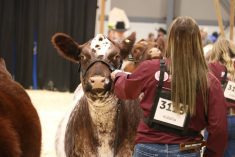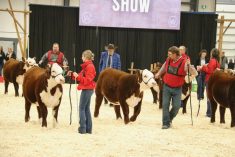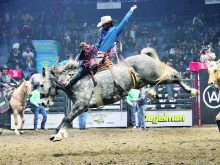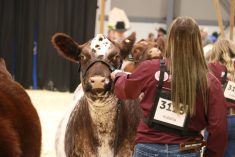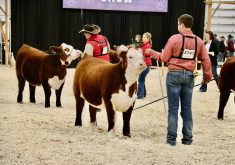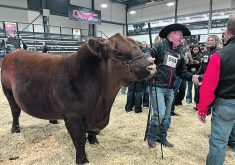The national youth show judge championships were held at Canadian Western Agribition in Regina last week
After an extensive two-day competition, 4-H crowned its national youth show judge champion at Canadian Western Agribition Nov. 21.
Justin Harcourt from Quill Lake, Sask., took home first place after beating out 74 other competitors from across the country, including Carmen White and Rhianna Gallagher from Ontario, who placed second and third, Hillary Schneider, also from Ontario, and Quinten Albrecht of Alberta. Harcourt and Albrecht were competing under the University of Saskatchewan banner with five other teams from the Prairies.
Other Agribition coverage:
- VIDEO: Simmental, Hereford top show
- First Nation establishes market garden
- Strong sales highlight 52nd Agribition, helped by weather
- Stock dogs show off their skills at Agribition
- Agribition Tech winners crowned
- Iowa school group gets a glimpse of Agribition
- Mexicans invest in Canadian Speckle Park
- Simmental clear winner at First Lady Classic
- Lonesome Dove Ranch finds success at Agribition
Read Also

New coal mine proposal met with old concerns
A smaller version of the previously rejected Grassy Mountain coal mine project in Crowsnest Pass is back on the table, and the Livingstone Landowners Group continues to voice concerns about the environmental risks.
Competition began in the preliminary rounds, where groups moved between Speckle Park heifers, dairy cows, heavy horses, Charolais bred heifers, Hereford bull calves and Texas longhorns. The top five were chosen to compete in the final round, where they judged four Black Angus heifer calves.
Harcourt grew up with Charolais cattle at his family owned and operated operation about two and a half hours east of Saskatoon. Starting with Canadian Charolais Youth Association programs and various conferences across Canada, Harcourt started judging at the age of 15, taking home second place at the Agribition youth competition in 2019.
This first place win has been a long time coming, he said.
“It’s really cool to finally get out there in front of a crowd and show what I know and it’s really nice to be rewarded for that,” he said following the competition.
Looking at his own Charolais breed, Harcourt said producers like animals that are structurally sound, especially with their expectations as a power breed, but they are also interested in the style and look of the animal. When judging so many different animals, Harcourt said, judges must have an ideal silhouette in their mind and judge as close to that as they can.
Even though the fourth-year agribusiness student was due back in Saskatoon for classes the next day, Harcourt was invited to judge the First Lady Classic as part of the championship prize as well as a $2,500 scholarship.
Being around that much high-quality, high-priced cattle was fun, he said after helping crown the championship heifer.
Samee Charriere judged the youth judges in that final round and had a lot of good advice for the finalists, especially in their presentation skills and how to be respectful and compassionate toward the competitors.
It’s really easy to find the bad in the animals, she said, but there’s always something the animal or the show person is doing right, and all the competitors found something good to say and had sound reasoning for their choices.
“All five did a great job of making sure you did that in every animal, not just the animal that you found to be last. And as you guys saw …you guys placed some different, and that’s fine. Have that confidence that you’re right today.”
The 4-H judging competition is always a challenge, said Garth Newell, 4-H committee chair and member of the Agribition board, but he was impressed with the level of knowledge the young people brought to the competition. From steak to different kinds of livestock, “it’s a broad scope that they have to be able to speak on and have general knowledge on to make it,” he said.
Nearly every province was represented at the event, with teams from Atlantic Canada, the University of Guelph, 4-H Ontario and PNE Vancouver.
Newell was also happy to see such a strong number of competitors with even more wanting to join. Competitors earn their place at the national show by placing at either a collegiate or 4-H event.





